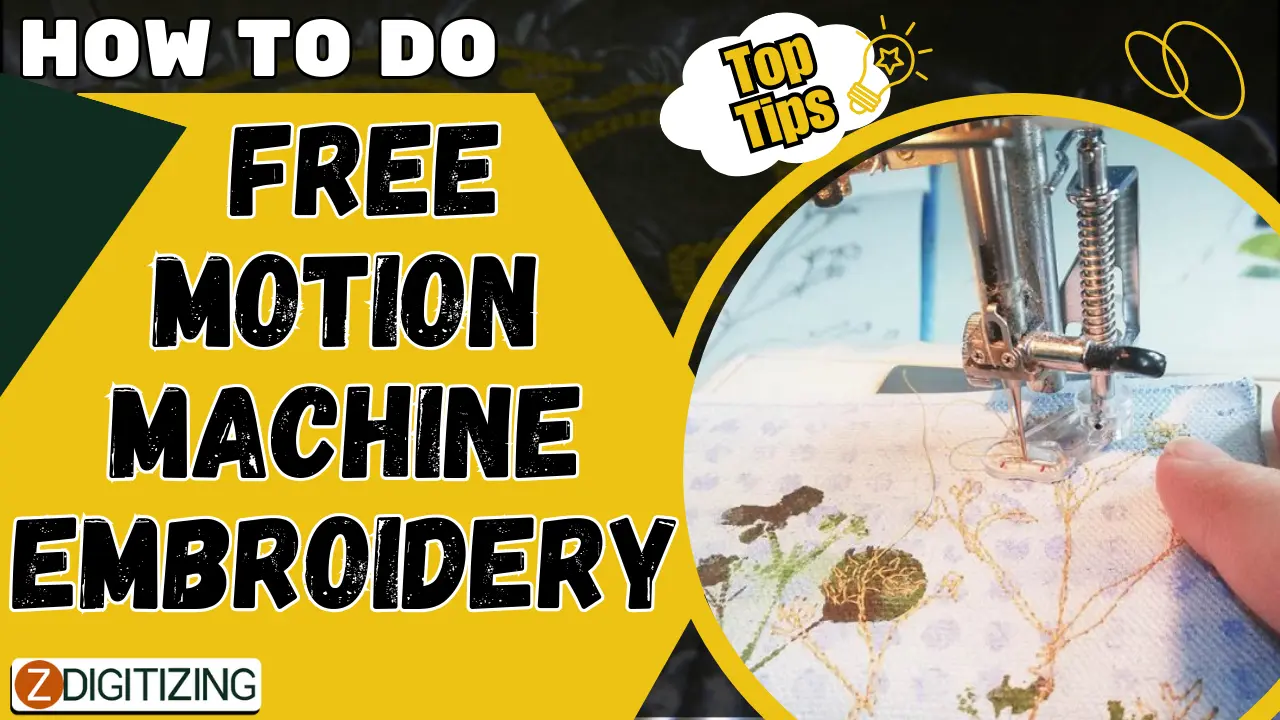Free motion machine embroidery is a versatile technique that allows embroiderers to create intricate designs with ease. Whether you're a beginner or an experienced embroiderer, mastering free motion embroidery requires practice, patience, and attention to detail. In this article, we'll explore top tips for successful free motion machine embroidery, along with the importance of utilizing embroidery digitizing services to convert designs into embroidery files.
I. Introduction
Free motion machine embroidery involves using a sewing machine with a darning or free motion foot to stitch designs onto fabric. Unlike traditional machine embroidery, free motion embroidery allows for greater flexibility and creativity in stitching designs. For beginners, learning top tips for successful free motion embroidery is essential for achieving professional-looking results.
II. Setting Up Your Machine
A. Adjusting Tension and Stitch Length
Before starting your embroidery project, ensure that your machine's tension and stitch length are properly adjusted. Experiment with different tension settings and stitch lengths to achieve the desired results for your specific fabric and thread combination.
B. Choosing the Right Needle and Thread
Selecting the right needle and thread is crucial for successful free motion embroidery. Use a needle suitable for the fabric you're embroidering on and choose threads that complement your design. Polyester or rayon embroidery threads are popular choices for free motion embroidery due to their strength and sheen.
III. Preparing Your Fabric and Hoop
A. Selecting Suitable Fabric
Choose a fabric that is suitable for free motion embroidery, such as cotton or linen. Avoid fabrics that are too stretchy or slippery, as they may be difficult to control during stitching.
B. Hooping the Fabric Securely
Hooping the fabric securely is essential for maintaining tension and preventing puckering during embroidery. Ensure that the fabric is taut within the embroidery hoop, but not stretched or distorted.
IV. Practicing Control and Technique
A. Starting with Simple Shapes and Lines
Beginners should start by practicing stitching simple shapes and lines to develop control and technique. Gradually progress to more complex designs as you gain confidence and proficiency in free motion embroidery.
B. Experimenting with Different Speeds and Movements
Experiment with different sewing machine speeds and movements to achieve varying effects in your embroidery. Practice stitching at slow and steady speeds for precision, and try varying your movements to create texture and dimension in your designs.
V. Utilizing Stabilizers
A. Importance of Stabilizers in Free Motion Embroidery
Stabilizers are essential for supporting the fabric and preventing distortion during free motion embroidery. Use tear-away or cut-away stabilizers depending on the fabric and design complexity.
B. Types of Stabilizers and Their Applications
Explore different types of stabilizers, including water-soluble, heat-away, and fusible stabilizers, to find the best option for your embroidery project. Experiment with layering stabilizers for added support and stability.
VI. Planning Your Design
A. Sketching Out Your Design Beforehand
Before starting your embroidery project, sketch out your design on paper to visualize the layout and composition. This will help you plan your stitching sequence and identify any areas that may require special attention.
B. Breaking Down Complex Designs into Manageable Sections
For complex designs, break down the design into manageable sections and stitch one section at a time. This approach allows for greater control and precision in stitching intricate details.
VII. Importance of Embroidery Digitizing Services
A. Role of Digitizing Services in Free Motion Embroidery
Embroidery digitizing services play a crucial role in free motion embroidery by converting hand-drawn designs into embroidery files compatible with embroidery machines. These services ensure that your designs are accurately translated into stitch files for seamless stitching.
B. Converting Hand-Drawn Designs into Embroidery Files
Submit your hand-drawn designs to embroidery digitizing services to have them converted into embroidery files. This allows you to stitch your original designs with ease and precision using your embroidery machine.
VIII. Troubleshooting Common Issues
A. Dealing with Thread Breaks and Tension Problems
Troubleshoot common issues such as thread breaks and tension problems by adjusting your machine's tension settings and checking for any obstructions in the thread path.
B. Fixing Puckering and Fabric Distortion
Address puckering and fabric distortion by ensuring that your fabric is hooped securely and using appropriate stabilizers to support the fabric during embroidery.
IX. Finishing Touches
A. Securing Loose Threads and Trimming Excess Fabric
After completing your embroidery, secure any loose threads and trim excess fabric to give your design a clean and polished finish.
B. Washing and Pressing the Finished Embroidery
Wash your finished embroidery gently to remove any stabilizer residue, then press it with a steam iron to smooth out any wrinkles and enhance the overall appearance.
X. Conclusion
Embarking on a free motion machine embroidery journey can be both exciting and rewarding. By following these top tips and utilizing embroidery digitizing service to convert your designs into embroidery files, you can achieve professional-looking results in your embroidery projects. Remember to practice regularly and experiment with different techniques to hone your skills and unleash your creativity in free motion embroidery.
FAQs
-
What is free motion machine embroidery?
- Free motion machine embroidery involves using a sewing machine with a darning or free motion foot to stitch designs onto fabric with freedom of movement.
-
Why is it important to use stabilizers in free motion embroidery?
- Stabilizers support the fabric and prevent distortion during stitching, resulting in cleaner and more professional-looking embroidery.
-
How can embroidery digitizing services help with free motion embroidery?
- Embroidery digitizing services convert to embroidery file compatible with embroidery machines, allowing for seamless stitching of original designs.
-
What are some common issues faced in free motion embroidery?
- Common issues include thread breaks, tension problems, puckering, and fabric distortion, which can be addressed through proper machine setup and troubleshooting techniques.
-
What are the best fabrics for free motion embroidery?
- Fabrics such as cotton and linen are ideal for free motion embroidery due to their stability and ease of stitching.


No comments yet